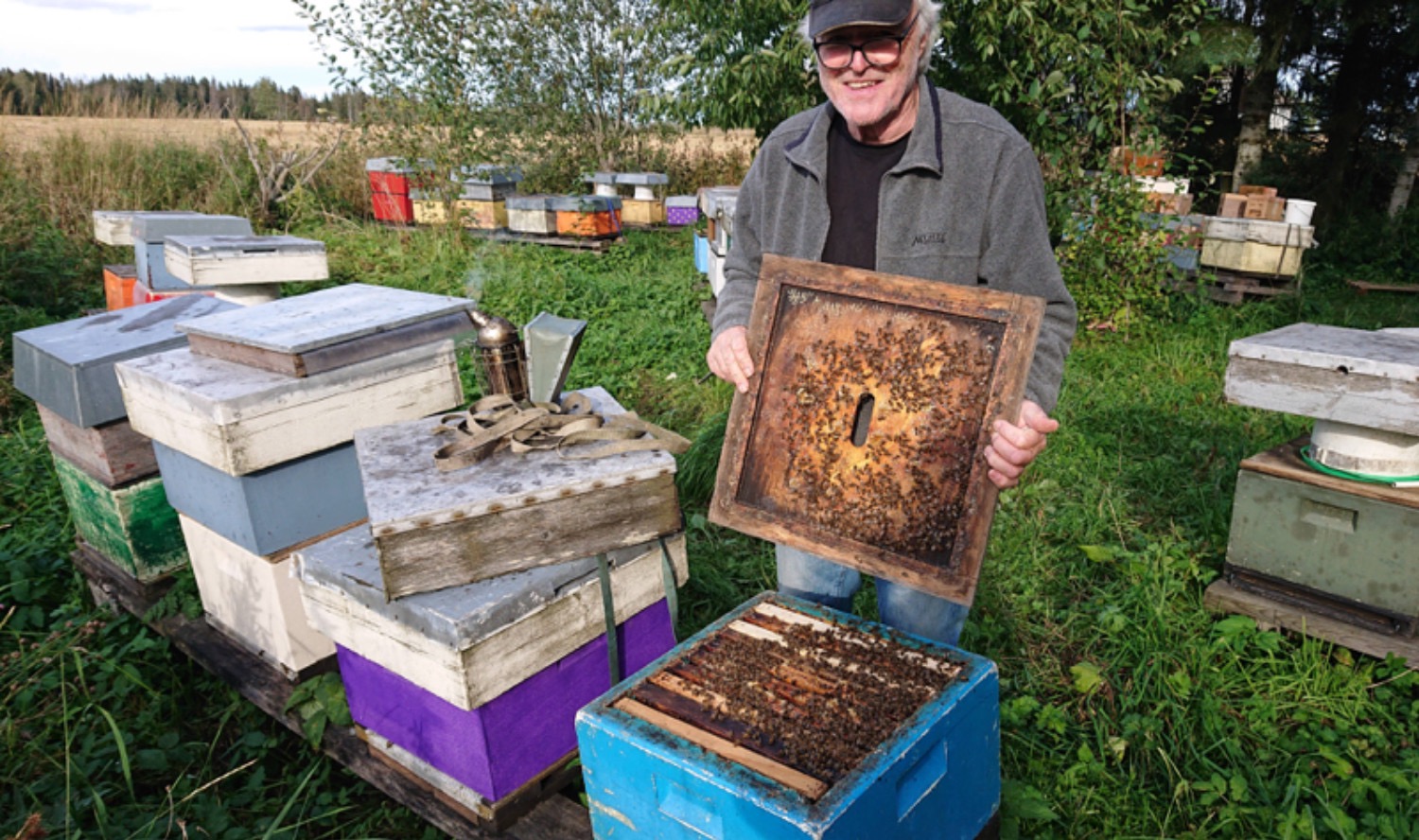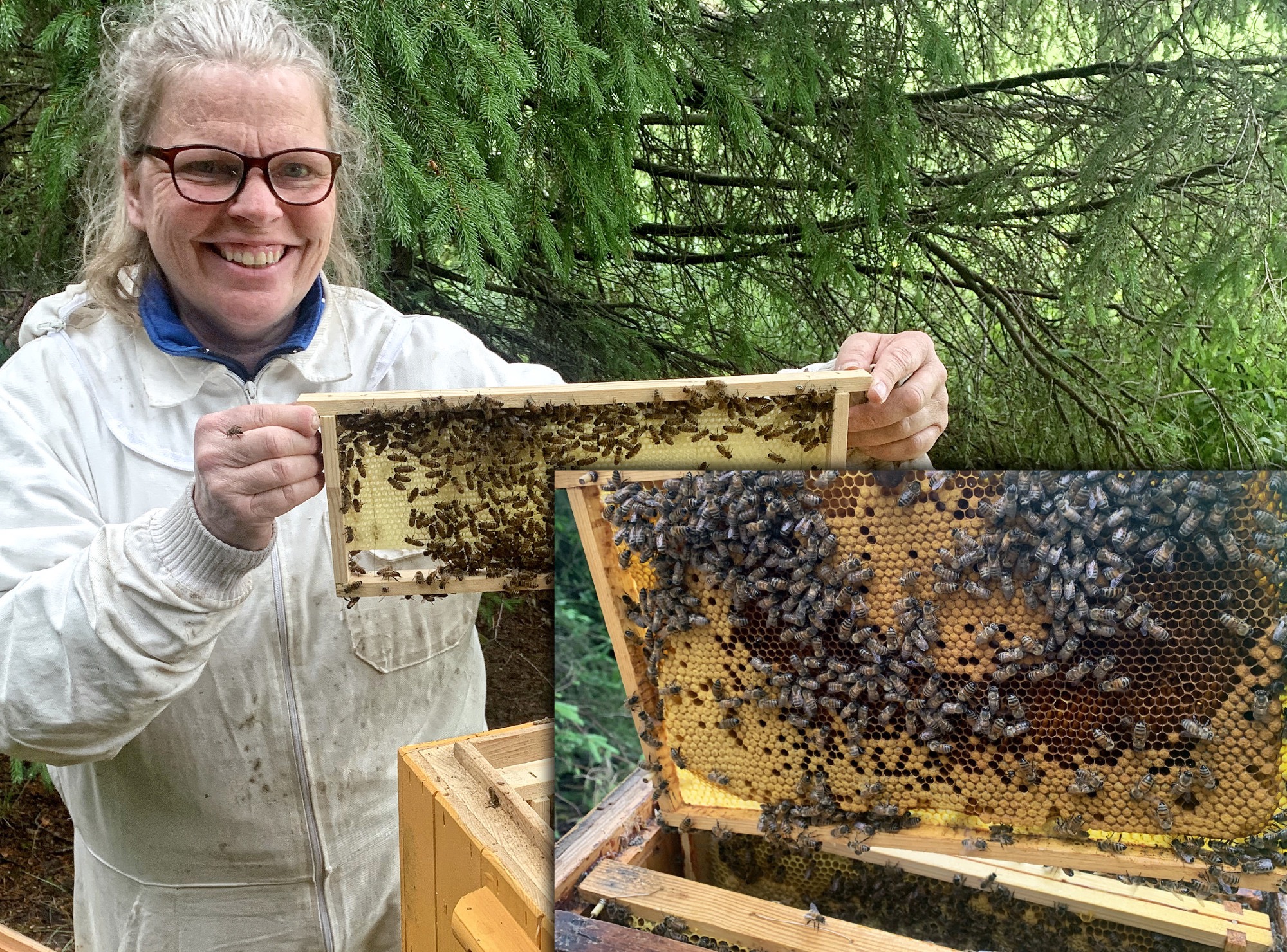The threshold
The Varroa mite was found in USA in 1987. In 1990 the threshold for treating against the varroa mite was maybe even higher than 15% varroa level, 15 mites on 100 bees from an alcohol wash of about 300 bees. Most treated all colonies preventive. It seemed easiest. Thus also the least resistant were saved to carry on their inferior hereditary traits. The 15% threshold was used by Dr Eric Erickson in 1995 in his breeding program for Varroa resistance:
2019 the threshold in USA was 3%. Dr Dennis van Engelsdorp on a conference in Gothenburg 2019 described the situation as very difficult in most areas of USA. In those areas, if the varroa level exceed 3%, a bee colony was doomed due too viruses (DWV mostly).
Virus laden bees
In 2020 Magnus Kranshammar in southern Sweden took care of a big swarm in beginning of July. It came from a meticulous beekeeper who kept the mite level low with drone brood removal in beginning of summer, fumigation of formic acid twice in middle of season and trickling oxalic acid when broodless late in season. Already when the first brood in that swarm hatched DWV-bees appeared and soon in such numbers that the colony was overtaken and the bees dwindled and died.
Microbiome
All living creatures live in a sea of microbes. The microbes form a mixture, a balance of for example bacteria, fungi and viruses that are inside and on all living beings. It is estimated that we humans have about 2 kg of microbes on and inside us. If the balance is disturbed, for example if you have to take antibiotics, then the stomach microbes are largely knocked out. The immune system is negatively affected, but short term the treatment may well have saved you. If you take showers and soap too much too often (three times a day), the microbiome on the skin is disturbed and fungal infections can take hold.
Insects also have microbiomes which are part of their immune system. When we use chemicals on our bees, natural or synthetic, especially in higher concentrations, it shouldn't be a surprise when it has negative effects on the longer term health.
Areas with no treatments
There are areas where no treatments have been used against the varroa mite, ever.
In Brazil in South America the varroa mite arrived in 1971. The Africanized bees had the control in the forests of Brazil. No bee colonies died due to the Varroa mite, in spite of that the varroa level was quite high the first years. The African bee is the same species as our European bee, both Apis Mellifera. In 1984 the average varroa level was about 5 % (phoretic mites, on the bees) and the bees was then called resistant. The virus level was evidently low in spite of what we today would have called a little to high mite level. Today the mite level on bees in Brazil (in brood it can be higher) it's more like 1-2%. The best suggestion is that some microbes in the natural microbiome (a mixture of different kinds of microbes) hindered viruses from growing to pathogenic levels. But when chemicals aimed to kill mites also affected the microbes, viruses could grow. It's not the first time similar things have happened due to chemicals. The famous book Silent Spring in 1962 by Rachel Carson contains several similar examples.
In 1984 20 colonies of Africanized bees were introduced to the island Fernando de Norhona 345 km northeast of the Brasilian coast. In the 20 colonies Italian queens were introduced and all Africanized drones and drone brood removed. There were no other bees on the island. After some years the varroa level was in average 30 % with the highest example of 50 %. The mites caused no apparent damage and deaths of the colonies. No chemical treatment for any reason was used in these colonies. The number of managed colonies were about 50 with two beekeepers for many years, as well as about 50 feral colonies. The varroa level of the colonies continued to decrease during the years to follow. In 2016 the varroa level had reached 1-2 %. (American Bee Journal, October 1997; DOI: 10.1038/srep45953)
In South Africa, beekeepers began to treat (managed colonies) against the varroa mite when it appeared in 2004. The overwhelming number of colonies though weren't possible to treat, all those swarms of scutellata flying back and forth, south and north. In the very south are cape bees, capensis. Into that area scutellata bees were helped arriving by beekeepers moving them. The feral swarms decided the terms for what happened to the whole of the bee stocks in the southern part of Africa.
There were colonies of beekeepers dying the first few years when the mite arrived, apparently due to virus (and mites). After some years resistance had increased among both Scutellata and Cape bees. Today they are considered resistant, but mite levels could vary, also in the same colony.
Among the African bees the cellsize of 4.9 mm is called natural.

Terje Reinertsen 2019. He has managed his bees for 25 years as if the varroa mite doesn't exist.
Terje Reinertsen
In 1994, the Varroa mite had made its presence so well known among beekeepers in Norway that it was decided that bee colonies had to be treated against the mite. The central association took help from countries where they had had more experience of the mite. Among other things, it was recommended to use "Krämerplatten" that evaporate formic acid in the bee colony.
Terje Reinertsen, in Norway 20 minutes north of Oslo, listened carefully to the advice and treated his bees in the recommended way in the Autumn of 1994. He lost 70% of his colonies in the Winter of 1994-95. Other beekeepers also lost about the same amount of bee colonies. Several lost 100%.
Spring treatment with formic acid was then mentioned as an additional alternative to save colonies that survived the Winter. Then fewer holes in the plastic around the formic acid soft board plate were used so that the evaporation speed would not be so high. Terje applied this method to the survivors.
After analyzing the results of all the treatments, Terje and a some other beekeepers concluded that if you were to loose so many bee colonies after treating, you could just as well not treat, because you didn't lose more colonies if you didn't treat.
His bees now havn't been treated for 25 years.
Now there has been some exciting research reports from the works of Dr. Melissa Oddie and her coworkers. Research on Terje bees was the basis for her doctoral dissertation. Since then, articles and reports of the bees of Terje Reinertsen have been published. https://www.elgon.es/diary/?p=416587
In 1995, Terje compensated for his colony losses by purchasing about 35 bee colonies. They came from an area where the Varroa hadn't yet arrived to. These colonies had never been treated against Varroa. They were higher in number than those that survived Varroa and formic acid.
In the Winter of 1995-1996 and onwards, the losses were again about normal, 5-10 %, despite the lack of Varroa treatment.
Because of the large losses of bees for many beekeepers in the winter of 1994-95, the reinvasion of mites was not a problem for Terje's bees. The initial arrival of mites came through some secret queen imports, says the rumor. Virus hadn't had time to multiply a lot in mites and bees due to the short time that had passed by.
Terje started at once with the simple breeding concept he has then followed through the years. He focused on identifying the inferior and the best bee colonies when it comes to keep down the mite population and being resistant to viruses. It seems the Varroa levels today mainly is 1-3%, with some exceptions at a higher level. The important thing is though that no signs of virus damages could be seen.
The cell size in his bee colonies is 4.9 mm.

Annelie Bosdotter 2020 and an average colony of her 15. The varroa level in all her colonies is 0-1%.
Annelie Bosdotter
In 2010, varroa was discovered in Annelie's bees. She lives at about 59°North 15°East. She took care of a swarm 10 years earlier and became a beekeeper. In 2010 she had received a number of local type of Buckfast colonies from a beekeeper. She had also taken care of some swarms of unknown descent. Other beekeepers' bees were several km from Annelie's bees. At this time she had 10 colonies.
She runs an organic small scale cattle and sheep farm together with her husband. She did not want to use strong or foreign chemicals on the bees. She once tried to treat capped brood frames without bees from a couple of colonies outside of the colony with formic acid. She did this only once. Her bees have never been exposed to any chemical treatment against varroa, organic (eg organic acids or thymol) or synthetic (such as Apivar and Apistan). No drone brood has ever been removed.
She has never bought queens or sent any for mating outside of her area. New queens are mated in her apiaries. Annelie lets the bees make their own queens, for example when a split is made as a swarm prevention measure, or when a split is made with a swarmcell, when such have been discovered. She normally has only a few colonies. 2 or 3, in each apiary.
10 years ago when varroa was discovered in her colonies and a few years thereafter she saw some wingless bees. At that time the number of her colonies was just over 10. Today she has about 15. The goal is now arrive at 50. She wants to dominate the area more with her varroa-resistant bees as new beekeepers have started to appear a little closer than they were from the beginning. However, she does not mind that there will be more beekeepers. Instead, it is an opportunity when you can cooperate in the area.
Winter losses are sometimes absent, sometimes 1-2, on average about 10%. For the winter, the bees are allowed to keep some honey, preferably 10-15 kg. Then they get a bucket of sugar solution made from organic sugar. Cell size throughout the entire hive is 4.9 mm.
In recent years, she has used the mobile app Beescanning to find out the varroa level in her colonies. She has taken pictures of most of the brood frames for the calculation but hasn't reached higher than 0-1%.
How to stop treatments
If you live in an area where the varroa mite has been treated for with organic or synthetic chemicals for many years, you have two options. If you want to be sure not to loose many colonies you have one option.
Whether you stop altogether at once, or stop stepwise, using less and less of treatment chemicals, there are some considerations that make the losses as few as possible.